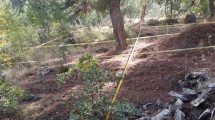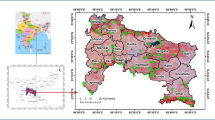Abstract
We evaluated the density and population height structure of Styrax argenteus in natural pine–oak forest and in Cupressus lindleyi plantations in Michoacan, Mexico. We also evaluated whether populations of S. argenteus in pine–oak vegetation and in C. lindleyi plantations had a clumped distribution. Finally, we evaluated whether advanced regeneration of different species was higher under the crown of S. argenteus than around it. Density of S. argenteus was higher in pine–oak forest than under plantations, but density in plantations was high. The structure of populations of S. argenteus in pine–oak vegetation had more individuals with ≤ 0.5 and >2 m, while populations in plantations had more individuals in intermediate height categories. Both populations were clumped. Only one species, Rubus liebmannii had higher densities under S. argenteus, so that other species might also colonize C. lindleyi plantations as a consequence to their affinity to S. argenteus. Although S. argenteus and other native species were apparently establishing under C. lindleyi plantations, Pinus and Quercus, the dominant genera of this forest type, were not. Consequently other activities, like liberation thinning, might be required to re-establish natural vegetation under C. lindleyi plantations.
Resumen
Evaluamos la densidad y estructura poblacional en categorías de altura para Styrax argenteus en bosque natural de pino-encino y bajo plantaciones de Cupressus lindleyi en Michoacán, México. También evaluamos si las poblaciones de S. argenteus en bosque de pino-encino y bajo plantaciones de C. lindleyi tenían una distribución agregada. Finalmente, evaluamos si la regeneración avanzada de distintas especies era mayor bajo la copa de S. argenteus, que alrededor de ésta. La densidad de S. argenteus fue mayor bajo vegetación de pino-encino que bajo las plantaciones, pero la densidad en plantaciones también fue alta. La estructura poblacional de S. argenetus en vegetación de pino-encino tuvo más individuos ≤ 0.5 y >2 m, mientras que la población en plantaciones tuvo más individuos en categorías de altura intermedias. Solo una especie, Rubus liebmannii tuvo densidades mayores bajo la copa de S. argenteus que alrededor de la misma, por lo que esta especie podría estar también colonizando plantaciones de C. lindleyi como consecuencia de su afinidad con S. argenteus. Aunque S. argenteus y otras especies se establecieron aparentemente en plantaciones de C. lindleyi, no fue así para los géneros dominantes en este tipo de bosque, Pinus y Quercus. Consecuentemente otras actividades, como cortes de liberación, sean necesarias para re-establecer la vegetación natural bajo dichas plantaciones de C. lindleyi.
Similar content being viewed by others
References
O. Alcántara I. Luna A. Velásquez (2002) ArticleTitleAltitudinal distribution patterns of Mexican cloud forests based upon preferential characteristic genera Plant Ecol. 161 167–174 Occurrence Handle10.1023/A:1020343410735
I.Y. Amezaga M. Onaindia (1997) ArticleTitleThe effect of evergreen and deciduous coniferous plantations on the field layer and seed bank of native woolands Ecography 20 308–318 Occurrence Handle10.1111/j.1600-0587.1997.tb00375.x
M. Camacho L. Orozco (1998) ArticleTitlePatrones fenológicos de doce especies arbóreas del bosque montano de la Cordillera de TalamancaCosta Rica Rev. Biol. Trop. 46 533–542
CONANP 2004. http://conanp.gob.mx/anp/anp.php(access April). .
A. Challenger (1998) Utilización y conservación de los Ecosistemas Terrestres de México. PasadoPresente y futuro CONABIO, Instituto de Biología UNAM, fundación Sierra Madre México, D.F 847
C.A. Chapman L.J. Chapman (1996) ArticleTitleExotic tree plantations and the regeneration of natural forests at Kibale National Park, Uganda Biol. Cons. 76 253–257 Occurrence Handle10.1016/0006-3207(95)00124-7
D. DeBell R.O. Curtis C.A. Harrington J.C. Tappeiner (1997) Shading stand development trough silvicultural practices K.A. Kohm J.F. Franklin (Eds) Creating a Forestry for the 21st Century Island Press Washington D.C. EUA 141–149
L. Galindo-Jaimes M. González-Espinosa P. Quintana Ascencio L. García-Barrios (2002) ArticleTitleTree composition and structure in disturbed stands with varying dominante by Pinus spp. in the highlands of Chiapas, México Plant Ecol. 162 259–272 Occurrence Handle10.1023/A:1020309004233
García Serrano E., Solís Calderón R. and Mora Álvarez X. 2003. Programa de manejo en el predio Villa CharoParque Nacional “Insurgente José María Morelos”. Procymaf-Semarnat, p. 56.
de Cosío M. 1984. Especies vegetales de importancia económica en México. Editorial Porrua. México DF. México, p. 305.
M.J. Hutchings (1997) The structure of plant populations M.J. Crawley (Eds) Plant Ecology Blackwell Science Singapore 325–358
INEGI 1995. Anuario estadístico del estado de Michoacán. Gobierno del estado de Michoacán and INEGI (eds), México.
E. Jurado J. Flores J. Navar J. Jiménez (1998) ArticleTitleSeedling stablishment under native tamaulipan thornscrup and Leucaena leucocephala plantation For. Ecol. Manage. 105 151–157 Occurrence Handle10.1016/S0378-1127(97)00276-4
A.E. Lugo (1992) ArticleTitleComparison of tropical tree plantations with secondary forests of similar age Ecol. Monogr. 62 1–41 Occurrence Handle10.2307/2937169
A.E. Lugo (1997) ArticleTitleThe apparent paradox of reestablishing species richness on degraded lands with monoculture For. Ecol. Manage. 99 9–19 Occurrence Handle10.1016/S0378-1127(97)00191-6
S.X. Madrigal G.M.P. Trujillo (2001) ArticleTitleAlgunas consideraciones para la planeación de plantaciones en la cuenca de Cuitzeo Mich. México. Cienc. Nicolaita 27 45–61
K.C. Nixon (1993) The Genus Quercus in Mexico T.P. Ramamoorthy R. Bye A. Lot J. Fa (Eds) Biological Diversity of Mexico: Origins and Distribution Oxford University Press Publishers New York 447–458
J.A. Parrotta J.W. Turnbull N. Jones (1997) ArticleTitleCatalizing native forest regeneration on degraded tropical lands For. Ecol. Manage. 99 1–7 Occurrence Handle10.1016/S0378-1127(97)00190-4
D.J. Parsons (2004) ArticleTitleSupporting basic ecological research in U.S. National Parks: challenges and opportunities Ecol. Appl. 14 5–13
E.C. Pérez (2003) Cambios en la biomasa y contenido de carbonoocasionados por el manejo de bosque. Reporte para: Ecología de Manejo de Recursos Forestales Centro de Investigaciones en Ecosistemas (CIECO), UNAM México
C.M. Pringle S.L. Collins (2004) ArticleTitleNeeded: a unified infrastructure to support long-term scientific research on public lands Ecol. Appl. 14 18–21
P.F. Quintana-Ascencio N. Ramírez-Marcial M. González-Espinosa M. Martínez-Icó (2004) ArticleTitleSapling survival and growth of coniferous and broad-leaved trees in successional highland habitats in Mexico Appl. Veg. Sci. 7 81–88 Occurrence Handle10.1658/1402-2001(2004)007[0081:SSAGOC]2.0.CO;2
Rzedowski J. 1988. Vegetación de México. LIMUSA (ed.) México, D.F, p. 432.
F. Senbeta E. Beck U. Lüttge (2002a) ArticleTitleExotic trees as nurse trees for the regeneration of natural tropical forest Trees 16 245–249 Occurrence Handle10.1007/s00468-002-0161-y
F. Senbeta D. Teketay B. Näslund (2002b) ArticleTitleNative woody species regeneration in exotic tree plantations at Munessa-Shashemene Forestsouthern Ethiopia New For. 24 131–145
J. Silvertown (1987) Introduction to Plant Population Ecology EditionNumber2 Longman Scientific & Technical Singapore 229
R.R. Sokal F.J. Rohlf (1995) Biometry: The Principles and Practice of Statistics in Biological Research3rd ed W.H. Freeman and Company New York, USA 887
B.T. Styles (1993) Genus Pinus: a Mexican Purview T.P. Ramamoorthy R. Bye A. Lot J. Fa (Eds) Biological Diversity of Mexico: Origins and Distribution Oxford University Press Publishers New York 397–420
F. Vargas-Márquez (1984) Parques nacionales de México y reservas equivalentes: pasadopresente y futuro Instituto de Investigaciones Económicas, UNAM México 266
G. Williams-Linera (2002) ArticleTitleTree richness complementarity, disturbance and fragmentation in a Mexican montane could forest Biod. Cons. 11 1825–1843 Occurrence Handle10.1023/A:1020346519085
J.H. Zar (1999) Biostatistical Analysis EditionNumber4 Prentice Hall New Jersey, USA 663
S. Zerbe (2002) ArticleTitleRestoration of natural broad-leaved woodland in Central Europe on sites with coniferous forest plantations For. Ecol. Manage. 167 27–42 Occurrence Handle10.1016/S0378-1127(01)00686-7
Author information
Authors and Affiliations
Corresponding author
Rights and permissions
About this article
Cite this article
Pérez-Salicrup, D.R., Peñaloza-Guerrero, C. & Aguiar-Eleutério, A.A. Regeneration of Styrax argenteus in natural forest and in plantations of Cupressus lindleyi in Michoacan, Mexico. New Forest 32, 231–241 (2006). https://doi.org/10.1007/s11056-005-6104-x
Received:
Accepted:
Issue Date:
DOI: https://doi.org/10.1007/s11056-005-6104-x




